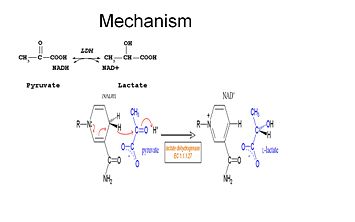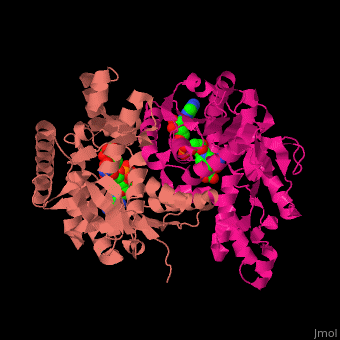Function
L-lactate dehydrogenase (L-LDH) catalyzes the interconversion of pyruvate and NADH+ to L-lactate and NAD+.
H-lactate dehydrogenase (H-LDH) catalyzes the interconversion of D-lactate and ferricytochrome c to pyruvate and ferrocytochrome c.
Lactate Dehydrogenase (LDH) is an important enzyme in humans. It occurs in different regions of the body, each region having a unique conformation of different subunits. LDH is a key enzyme in anaerobic respiration. Anaerobic Respiration is the in the absence oxygen. This pathway is important to glycolysis in two main ways. The first is that if pyruvate were to build up glycoysis and thus the generation of ATP would slow. The second is anaerobic respiration allows for the regeneration of NAD+ from NADH. NAD+ is required when glyceraldehyde-3-phosphate dehydrogenase oxidizes glyceraldehyde-3-phosphate in glycolysis, which generates NADH. Lactate dehydrogenase is responsible for the anaerobic conversion of NADH to NAD+. in the Lactate Dehydrogenase from Cryptosporidium parvum (4nd4).
See also: Cori cycle, Gluconeogenesis.
Human Lactate Dehydrogenase
Structure
is a quaternary protein formed of the combination of two subunits, M and H (Muscle and Heart) into a structure of four of the subunits. The various combinations found in the human body are:
- (4H) Heart
- (3H1M) Reticuloendothelial
- (2H2M) Lungs
- (1H3M) Kidneys
- (4M) Muscle and Liver
The of LDH as shown here is comprised of 40% alpha helices and 23% beta sheets[1]. The SCOP data classifies this form of lactate dehydrogenase as mixed beta-alpha-beta, with mainly parallel beta sheets.
See also
Catalysis
Studies have shown that the reaction mechanism of LDH follows an ordered sequence.

In order for lactate to be oxidized NADH must bind to the enzyme first followed by lactate. . Once the NADH is bound to the enzyme, it is then possible for lactate to bind (substrate oxamate is shown; the ‑CH3 group is replaced by ‑NH2 to form oxamate). Lactate binds to the enzyme between the nicotinamide ring and several LDH residues. Transfer of a hydride ion then happens quickly in either direction giving a mixture of the two tertiary complexes, enzyme-NAD+-lactate and enzyme-NADH-pyruvate .Finally pyruvate dissociates from the enzyme followed by NAD+[2].

Kinetics
Kinetic studies of lactate dehydrogenase with oxalate and oxamate (structural analogues of lactate and pyruvate)have proven the mechanism stated above. The rate limiting step in this reaction is the rate of dissociation of NAD+ and NADH. The conversion of pyruvate to lactate with the subsequent regeneration of NAD+ is very favorable.

Regulation
As the mechanism is one of equilibrium, There appears to be no regulation specifically designed for lactate dehydrogenase, instead it is dependent on the activation of anaerobic reparation and the presence of pyruvate and NADH, or lactate and NAD+.
3D structures of lactate dehydrogenase
Lactate dehydrogenase 3D structures




